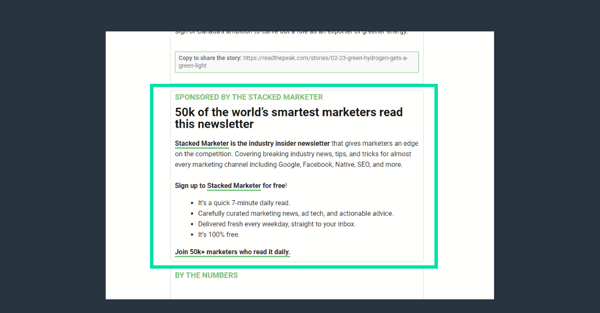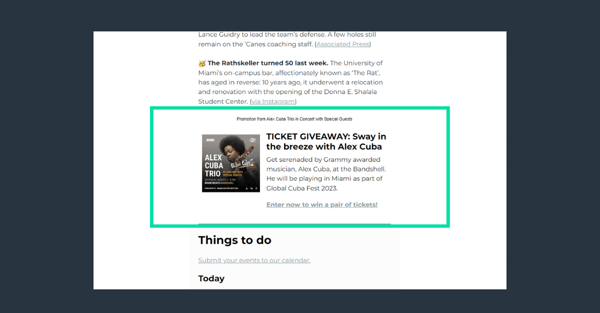Maximize Your Newsletter's Revenue: Advertising Formats You Need to Know
Unlock your newsletter's revenue potential with these seven effective advertising formats. Learn how to align with your brand and reach an engaged audience
- Published
- Reading time
Bruce is a creative explorer, blending art, entrepreneurship, and technology to create projects that inspire and involve people in surprising ways. A co-founder of Letterhead and Head of Marketing.
Explore seven practical and easy-to-implement advertising formats for newsletters in this breakdown. From newsletter sponsorship to native advertising, learn about different ways to align with a publisher's brand and reach an engaged audience.
Summary: Learn the seven most common formats to sell advertising in your newsletters to help you make more money and connect with your audience. These include full newsletter takeovers, native advertising, title and text ads, sponsored listings, section sponsorships, and banner ads. Plus, you'll learn how to use these formats as part of a bigger plan to grow your business. 👉 Download our full monetization guide.
Full Newsletter Takeover:
- Advertiser becomes the presenting sponsor of the entire newsletter edition without any other advertisers in that newsletter. Typically uses language like in partnership with, made possible by, or presented by to align the advertiser with the publisher's brand.
- The advertiser gets the highest possible billing and alignment with the publisher's brand, making it easy to present and explain to an aligned advertiser in a sales conversation.
- Selling other inventory in the same newsletter can be difficult and involves custom production.
- Variation: Customized header or banner for the newsletter with the advertiser's name or creative included.
Native advertising (content marketing):
- The publisher's team produces a custom advertisement for the advertiser that fits the brand's voice and tone.
- The native ad is an expanded text section with an image or follows closely to other newsletter sections. It should look and feel similar to the other content around it.
- Provides a larger space to get people interested in the advertiser.
- It can be used with a title or newsletter sponsorship.
- Note: It can be expensive and time-consuming to produce and requires dedicating a meaningful space in the newsletter to the advertiser.

Title ads:
- Ad units are placed near the introduction or top of the newsletter.
- Provide the full advertisement, including text, links, and images, above the fold.
- Advertisers get premium placement without splitting the content into multiple places.
- Note: It’s crucial to design title ads to avoid distracting content due to poor editorial images or too much text forcing the content below the scroll on the phone.

Text Ads:
- Text-only units are integrated with the rest of the copy in the newsletter.
- Text ads are often placed interstitially between stories or content blocks.
- They are designed to feel visually consistent with the text items above and below.
- Least likely to get skipped over by readers.
- Some publishers do native, text-only ads where their team produces the items to match the format of their other stories/content items exactly.
- Note: Text-only means the copywriting has to be compelling for it to perform.
Sponsored Listings:
- The advertiser pays for placement in other items, such as events, real estate listings, or jobs.
- The publisher has a recurring section dedicated to listings, with some or all offered as paid placements.
- Paid placements are sometimes given a more prominent design in the list, such as bold or more text.
- Allows advertisers to guarantee premium placement in the list while still fitting in with the design and content of the newsletter.
- Remember: This unit has value if the publisher has an event calendar that readers love and look forward to. If not, these ads will be harder to sell.

Section sponsorship:
- The advert becomes the recurring sponsor or places an ad in a specific newsletter section.
- If the newsletter has ongoing, recurring sections (such as news of the day or a weekly product round-up), a section sponsorship is a way for the advertiser to align with that specific content.
- Valuable because it allows the advertiser to align with specific content and reach an engaged audience.
- Consider: Ensuring that the sponsored content is relevant and adds value to the reader is vital.
Banner ads:
- The most traditional type of newsletter advertising, with a banner or logo placed at the top, bottom, or sides of the newsletter.
- Easy to produce and can be sold on a CPM (cost per thousand impressions) basis. Consider: They can be less effective as they are often ignored by readers and can be seen as disruptive to the content.
- The most traditional type of newsletter advertising, with a banner or logo placed at the top, bottom, or sides of the newsletter.
- Easy to produce and can be sold on a CPM (cost per thousand impressions) basis.
- Consider: They can be less effective as they are often ignored by readers and can be seen as disruptive to the content.
How to use these formats best:
Once you've chosen the proper advertising format for your newsletter, it's time to consider how it can support your broader fulfillment strategy. There are several ways to use newsletter advertising to drive revenue, and it's up to you to determine what works best for your business.
Here are some examples:
- Referral and affiliate marketing: If you have a referral or affiliate marketing program, you can use banner ads, text ads, or sponsored listings to promote your partners' products and services. These advertising formats can help you generate revenue through referral fees or commissions on sales.
- Promoting products: If you have your products or services to sell, you can use text ads, title ads, or native ads to promote them to your newsletter subscribers. You can drive sales and generate revenue by showcasing your products in your newsletter.
- Programmatic display ads: Using a programmatic ad marketplace like Letterhead's Ad Marketplace, you can serve up display ads in your newsletter that are targeted to your audience based on their interests and behaviors. This advertising can generate revenue for your business while providing value to your subscribers with relevant, engaging content.
- Self-service ads: If you have a self-service ad platform, you can offer a range of ad formats for advertisers to choose from, including text ads, title ads, and banner ads. This allows advertisers to easily book and pay for ads in your newsletter, generating revenue for your business.
- Sales-led creative studio: If you have a creative studio, you can offer customized ad campaigns that mix different ad formats to meet your client's needs best. This approach allows you to create unique, engaging ad campaigns that drive revenue for you and your clients.
- House promotions: Let readers and potential advertisers know how they can work with you; this is most commonly seen as an "advertise here" type of promotion. Do you have any big initiatives in development? This is a great place to test out marketing messages that resonate and expand business with professionals already familiar with your newsletter.
By knowing the different kinds of advertising, you can use, and how they can fit into your larger strategy for the fulfillment, you can make the most money and grow your business.
In conclusion, there are many ways to advertise in a newsletter, each with pros and cons. There's something for every advertiser and publisher, from newsletter sponsorship to native advertising, title ads to text ads, sponsored listings to section sponsorships, and banner ads.
Download our monetization guide to learn more about making the most of your newsletter.

